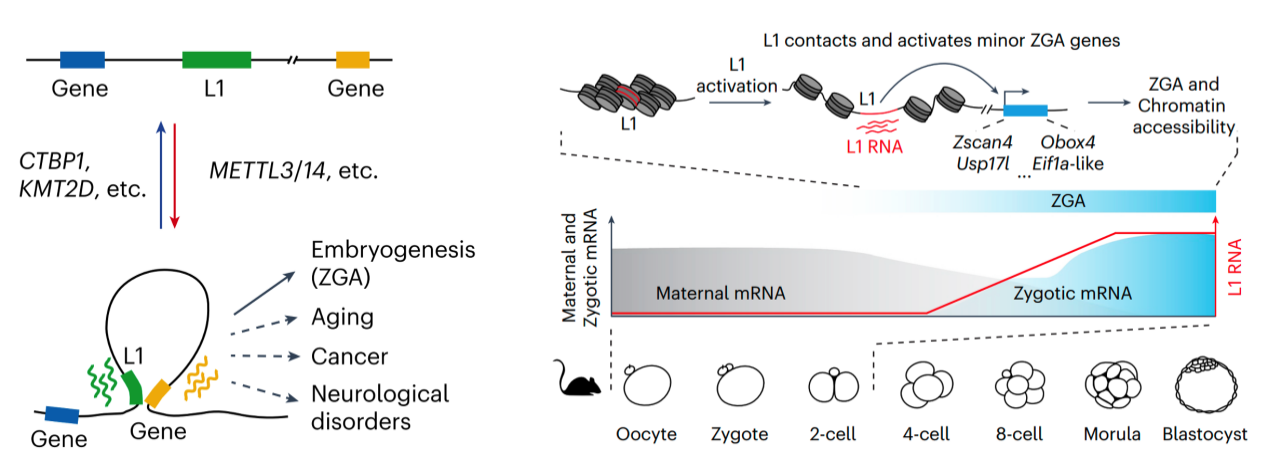In the 1950s, Barbara McClintock first discovered a class of DNA sequences in maize capable of moving within the genome and changing their position—these are known as transposons. This groundbreaking discovery earned her the Nobel Prize in Physiology or Medicine in 1983. Nearly half of the human genome consists of transposons, with Long Interspersed Nuclear Element-1 (LINE-1 or L1) accounting for approximately 17% of the human genome. Notably, L1 is the only active transposon in humans that retains the ability to autonomously transpose via reverse transcription. Although L1 expression is typically repressed in somatic cells, it is transiently and highly expressed during the zygotic genome activation (ZGA) in early embryonic development in both humans and mice. This indicates not only the stringent and precise regulation of L1 expression but also suggests its crucial role in key physiological processes. However, there still remains a limited understanding of how L1 expression is regulated and its functional roles in gene regulation and ZGA.
On June 7th, Nian Liu's research group from the School of Life Sciences at Tsinghua University published a paper titled "LINE-1 transcription activates long-range gene expression" in Nature Genetics. This study provides the first genome-wide screening results on the regulation of L1 expression, systematically identifying and validating the extensive role of L1 in long-range gene activation. The findings elucidate how L1 transcription facilitates the ZGA process in early embryos, offering a new perspective for understanding the physiological functions of L1 in development and disease.

Figure 1. The transcriptional levels of L1 are intricately regulated by a diverse set of genes, which also govern L1’s selective interaction and activation of long-range gene expression. This regulation plays a crucial role in early embryonic development, particularly in zygotic genome activation (ZGA), and may also impact processes such as aging, cancer, and neurological disorders (left). L1 transcription triggers the first wave of transcriptional activity during early embryonic development in mice, known as minor ZGA (right).
Nian Liu’s lab has long been engaged in the study of retrotransposon regulation and function. Previous work from the lab systematically identified regulatory factors involved in the L1 transposition process and discovered that L1 can function as a topological domain boundary. Here, using a genome-wide CRISPR-Cas9 screen, they revealed that many of the regulatory factors affecting L1 expression are associated with enhancer regulation and function, such as KMT2D, CTBP1, METTL3, and METTL14, suggesting that L1 may possess enhancer activity. By systematically mining data from genome-wide self-transcriptional active regulatory region sequencing (STARR-seq), they found that the 5’ untranslated region (5’ UTR) of L1 exhibits enhancer characteristics and can activate gene expression independently of its position or orientation. Using the CRISPRa/i system to target the L1 5’ UTR, they demonstrated that L1 can directly physically interact with its distal target genes, with this interaction being strengthened upon L1 activation and weakened when L1 is silenced.
To investigate the role of L1 in ZGA, the researchers first compared L1 insertion and gene expression changes during early embryonic development between human and rhesus monkey genomes, finding that lineage-specific L1 insertions might enhance ZGA gene expression. Further analysis revealed that the mouse L1 5’ UTR is also enriched in enhancer signals. Therefore, they manipulated L1 expression in mouse embryonic stem cells using CRISPRa/i and L1 antisense oligonucleotides (ASO), discovering that L1 selectively regulates the expression of two-cell-specific genes. Public scRNA-seq and Hi-C data from mouse embryonic development showed that L1 expression begins in the early two-cell stage, where it directly interacts with and activates minor ZGA genes. By injecting L1 ASO into mouse zygotes, they found that L1 knockdown impairs ZGA and arrests mouse embryonic development at the 2-4 cell stage.
In summary, this study identified diverse regulators of L1 expression, demonstrating that the L1 5’ UTR functions as an enhancer that interacts with and activates ZGA genes in a transcription-dependent manner during early embryonic development. Given that active L1 transposition continues to amplify its presence in the human genome, L1 may continually add new cis-regulatory DNA elements, thereby influencing various human diseases and developmental processes. This work provides valuable resources for studying the regulatory network of L1, uncovering the complexity and diversity of L1 expression regulation, explaining why L1 is activated during embryonic development, and offering new insights into L1’s function within the genome.
The corresponding author of the paper is Dr. Nian Liu from the School of Life Sciences at Tsinghua University and the Tsinghua-Peking Center for Life Sciences. Xiufeng Li, Luyao Bie, Yang Yang and Yaqiang Hong are the co-first authors. This research received significant assistance from Professor Wei Xie, Professor Anming Meng, Associate Professor Qiaoran Xi, Professor Xiaohua Shen, Chang Zai and Zhang Jing. The study was supported by the Tsinghua-Peking Center for Life Sciences, Beijing Frontier Research Center for Biological Structure, the National Key R&D Program, the National Natural Science Foundation of China, the Independent Research Plan of Tsinghua University, and the Benyuan charity foundation.
Full text: https://rdcu.be/dRwtH or https://www.nature.com/articles/s41588-024-01789-5
Editor: Li Han

